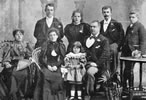Balls and formal dinners
Formal balls were one of the first signs of sophistication in New Zealand towns. In Wellington the first anniversary of the settlers’ arrival in 1841 was celebrated with a ball for the ‘select’ in Barrett’s Hotel and a ‘popular’ ball in a wooden store three days later. In the 1850s during Wellington’s winter ‘season’ (April to August), balls that ran from nightfall to early morning were held almost monthly. There were also celebratory banquets. Referring to the balls, dinners and events in Wellington, the Taunton Journal, a British newspaper, commented that ‘the general appearance of the place resembles Hastings or Brighton [English seaside towns]’.1
Meaty meal
There was an impressive bill of fare at the celebratory dinner for 180 held by Hutt settlers in honour of Sir George Grey in 1851. The meal included three rounds of beef, six large pieces of pressed beef, six boiled legs of mutton, two saddles of mutton, four hams, four tongues, five geese, 12 ducks, three turkeys, three suckling pigs, four chickens, 12 fowls, three pigeon pies, and six beef steaks. Vegetables were not entirely forgotten – there were also 75 kilos of potatoes, 32 kilos of turnips, 23 kilos of carrots, 20 large cabbages and 9 kilos of parsnips.
Amateur music
In the 19th century a remarkable number of cultural institutions were established, and commercial entertainment began in the cities. Soon after arriving, settlers organised amateur performing groups. At the heart of amateur colonial music in the cities were the choral societies, which involved large numbers of singers. The Auckland Choral Society (set up in 1855) involved 200 singers and a 60-strong orchestra. It was followed by the Canterbury Vocal Union (1860), and choral societies in Wellington (1860) and Dunedin (1863). Later there were liedertafels (men’s singing groups) and operatic societies. Other forms of amateur music appeared in the cities. By the 1880s there were at least four brass bands in Christchurch, while Invercargill and Dunedin had pipe bands.
Professional music
Cities set up musical venues such as the New Musical Hall, also known as ‘the barn’, which opened in Christchurch in 1861. Dunedin’s Music Hall opened the next year. Such places hosted both amateur productions and travelling professional musicians, who visited from the 1860s. They included violinists, pianists and singers from European concert chambers.
Larger companies also visited. In 1864 Lyster’s Royal Italian and English Opera Company played 12 nights in Christchurch, performing such classics as Lucia di Lammermoor and Il trovatore. Between 1876 and 1889 Simonsen’s opera company visited New Zealand cities four times. Lighter opera, and musicals such as those of Gilbert and Sullivan, toured under the auspices of J. C. Williamson from the 1880s. Their major competition was Tom Pollard’s Liliputian Opera Company, with its musical comedies and pantomimes. Also popular were troupes of black American minstrels performing spirituals. Often such companies visited New Zealand cities in the winter, when the northern-hemisphere season was over.
Curtain-raisers
The orchestra pit in colonial theatres was a lively place. While waiting for the show to begin, those in the pit would sing popular songs, or taunt those arriving – especially well-known citizens in the front stalls. As for late-comers, they were received ‘with expressive Uh-Uh-Uhs, - an Uh for every sideward push past the knees of the resentful seat-occupiers: the portlier the Uh-ier’.2
Travelling entertainers
Travelling actors also performed in the cities. At first, plays were performed in saloons attached to pubs, but theatres soon followed. The Theatre Royal was a favourite venue in Christchurch from 1866. It had a door in the dress circle so patrons could pay a visit to the neighbouring Shakespeare Hotel.
Initially much of the drama was amateur. The programmes included short farces with songs and recitations. From the 1880s there were visits from overseas professionals. Australian-based theatre producer Bland Holt toured eight times between 1882 and 1900, presenting 33 melodramas, usually drawn from the London stage.
The cities were also visited by circuses, elocutionists and celebrity lecturers like William Booth of the Salvation Army (1889), the explorer Henry Stanley (1892) and the American writer Mark Twain (1895).
Museums, exhibitions and art
By 1870 there were three city museums – Auckland (1852), the Colonial Museum in Wellington (1865), and Canterbury museum in Christchurch (1870). More lively than the museums were the exhibitions held in colonial cities, which combined displays of industrial and agricultural produce with art and side-shows. Johannes Andersen remembered the 1882 Christchurch exhibition as ‘a place full of allurements and temptations’.3
Societies of artists were set up in Auckland in 1869, Dunedin in 1876 and Christchurch in 1880. Auckland Art Gallery was established in 1888. In Wellington the New Zealand Academy of Fine Arts was set up in 1889, and a gallery to show works opened in 1907. However painter James Nairn and his friends had established the Wellington Art Club in 1892.
By 1900 the four main cities had institutional structures for cultural pursuits and recreations. When people in other districts wanted to hear a professional concert or watch the latest London melodrama, they came to the city.


